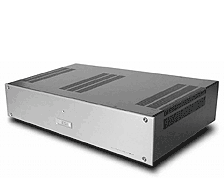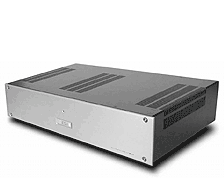


Ever since Roksan launched the Caspian line, I've been a fan. Nearly 75 percent of my weekly listening time involves a Caspian integrated amp and CD player, employed for almost all of my software reviewing, and I even feed my computer soundcard into it. Let's just say that its sound is not unfamiliar. So it was with much enthusiasm that I greeted the Roksan AV Five-Channel Amplifier, the first Caspian model with deliberate home theatre aspirations.
Additional Resources
• Read more multichannel amp reviews from the likes of Anthem, NAD, Krell, Mark Levinson and many others.
Roksan has attacked the A/V issue with total commitment, betraying none of the half-hearted nonsense which the wavering, under-pressure-from-the-market two-channel wussies exhibit. The company has already issued this amplifier and a complement of A/V-dedicated speakers (see sidebar). To follow in due course are two units seen in prototype form - a sub-woofer and an A/V surround pre-amp with Dolby Digital circuitry - which I suspect will be in the shops by Christmas, if not, then just in time for the Winter CES. So are we being a bit premature in reviewing only part of the package? Perhaps, but it did make it easier for me to assess the five-channel power map on its own: I merely slotted it into my reference system of Pioneer DV-414 and DVL-919 DVD players, Lexicon MC-1 pre-amp processor and Apogee LCR/Ribbon Monitor loudspeakers. What the Roksan replaced was an Acurus amp with 3x200W and a Marantz with 5x50W.
Bearing the family look of natural metal fascia with chamfered corners and an elongated oval window, the AV Five-Channel Amplifier measures 432x430x85mm (WDH), making it the same width as its Caspian brethren but taller and deeper. Like the CD player, of which I could never understand why it sports two play/pause buttons, the display on the AV5 (as I'll call it for brevity) has an on/off button at either end of the display. Maybe the Roksan boys are ambidextrous. Whatever, the buttons take the AV5 out of standby mode or put it back; primary on/off is a rocker switch at the back.
AV5's array of icons in the window tell you when the unit is in power on mode (the first icon on the left glows green for on or red for off), while the remaining icons indicate overload. As I never activated them, even when using
Roksan sells this beauty for a meagre £995 - a genuine bargain - but I gather that the chassis will be available in three- and four-channel form for a slight savings: £795 for three, £895 for four. With the lid removed, you can see that each channel is a self contained module, powered off a massive toroidal transformer power supply in the front-centre. Given that this will appeal to Caspian integrated owners moving from two- to five-channel systems, the option is considerate, and you need never feel locked into a three- or four-channel version because the factory will retrofit the extra channel or two needed for a full five-channel array. As for matching, the AV5's 80W/channel is so close to the Caspian integrated's 70W/ch that there's little likelihood of a mismatch. Worried? Then use the integrated's two channels to drive the rear speakers. (Note that the Caspian integrated, from Day One, has offered pre-our/amp-in sockets so you can use it just as a pre-amp or stereo power amp.)
After letting the AV-5 idle for 30 minutes, I blasted through the usual challenges -
What did it sound like? A Caspian integrated with multiple personalities, pentaphenia as it were. Assessed first using just the two main channels and with the Linn Genki CD player as source, driven by the Caspian integrated as a pre-amp, I could detect minor improvements over the now two-year-old integrated, mainly in the area of dynamics. I don't want to attribute this to an extra 10W, but the AV5 certainly seemed better able to deal with fast and/or extreme swings from soft to loud, exhibiting no break-up at levels which would start to worry the integrated. In real terms, this manifests itself as a punchier sound.
Conversely, with levels matched precisely, it would be impossible to mistake the AV5 for anything other than the product of the same stable as the Caspian integrated. To further assess the relationship, I also used three channels of the AV5 and the two of the integrated amp, all driven by the Lexicon, and could barely detect a difference worth noting with tonal sweeps. In other words, if you already own a Caspian integrated, three channels worth of AV5 are all you need to go Rialto.
With a delightful show of consistency, the AV5 confirmed the description I made of the integrated: 'A neutral midband, leaning toward the dry. Precise treble, with no excesses - neither bright nor dull, but fast and crisp enough to suggest the former. Extended bass that makes up for a slight but audible lack of control and damping... consistent speed and effortless dynamics'. What's changed, and what probably
Quite clearly, Roksan's first A/V product is a smash hit. For a British amp, it brazenly, defiantly embraces the home cinema ethos by offering guts, set-and-forget dependability (or protection circuitry peace-of-mind), ease-of-use, dynamic prowess worthy of an effects-laden blockbuster, and - for the times when the TV monitor is off - enough finesse to do justice to the Beatles. Admittedly, it was the first time I'd heard 'All You Need Is Love' and Nowhere Man' as five-channel creations, but I'm sold: the system sounded just as good when I later fed it the remastered, two-channel-only CD.
We can only wait to see if Roksan has given us a complete package. The speakers work beautifully, the AV5 amp is a delight. So, roll on, subwoofer and processor/pre-amp. But please don't take as long as George Lucas.
Roksan Audio Ltd, Unit 6 Northfield Industrial Estate, Beresford Avenue, Alperton, Middlesex HA0 1NW. Tel 0208 900 6801
*Note: this cartoon is justification enough for subscribing to Sky. Johnny Bravo's voice is the finest impression of Elvis Presley I've ever heard, and his every move is in Elvis' Las Vegas/karate style. Or, to use his parlance, 'Oh, Mamma!'
SIDEBAR: ROKSAN SURROUND SPEAKERS
Along with the amplifier, Roksan supplied their full five-channel set of surround-sound speakers: four AV5 surrounds and an AV5 centre channel. It's no secret that these are made exclusively for Roksan by Spendor - and there is no Spendor-badged equivalent - but some of you might be wondering how the link was formed. Oh, ye of short memories! Not all that long ago, Roksan was part of the Verity group (now NXT), the family including Mission, Cyrus and - not least - Quad. And if you recall the luscious, sublime Quad 77-10L, you'll remember that it was made for Quad by...Spendor. Given that Roksan and Quad had desks facing each other in Huntingdon, the likelihood that Roksan knew the guys at Spendor is high. And it's a good thing, because the Roksan AV5 is a killer.
Each main speaker costs 330, with the centre-channel model costing 350. This pays for a grill with a centrally-located badge with only 20 percent of the production potential of the one with the badge at the narrow end used in the vertical models, as well as for a neat angled block arrangement below the cabinet. This fitment allows the user to place the speaker below a monitor firing upwards, mount it upside down on the ceiling, firing downward, or remove it altogether for positioning on top of a large monitor; I used it on top of a 29in Panasonic set. That feature aside, all of the units are rear-ported two-ways containing two Spendor 130mm Filled Homopolymer cone woofers flanking a VIFA TC20 20mm soft-dome tweeter; crossover point is 3.3kHz. The speakers are bi-wireable via multi-way binding posts at the back, with easily removable plugs put there in the first place because of some Belgian eunuch.
Finished in 'video grey' with a gloss black top panel and a black grille, each 8.1kg enclosure is made from damped MDF and measures 480x156x285mm (HWD), with the centre channel mounted horizontally at 480x156x285mm (WHD); the latter's angle bar adds around 50mm to the middle dimension. These are slim, sleek, shielded enclosures, and - with either stand, shelf or wall-mounting - they'll cause no domestic crises.
As you'd expect, they were 'naturals' for use with the AV5, never taxing its 80W/ch. They offer sensitivity of 88dB, an impedance of 6 ohms and maximum SPLs of 103dB. Stated frequency range is 65-20kHz (+/-3dB), but never did I feel hunger pangs for more bass. That's because these speakers kick some serious butt.
Whether using pure music or video, the AV5s were always exciting and vivid. Colorations? Who cares? We're talking